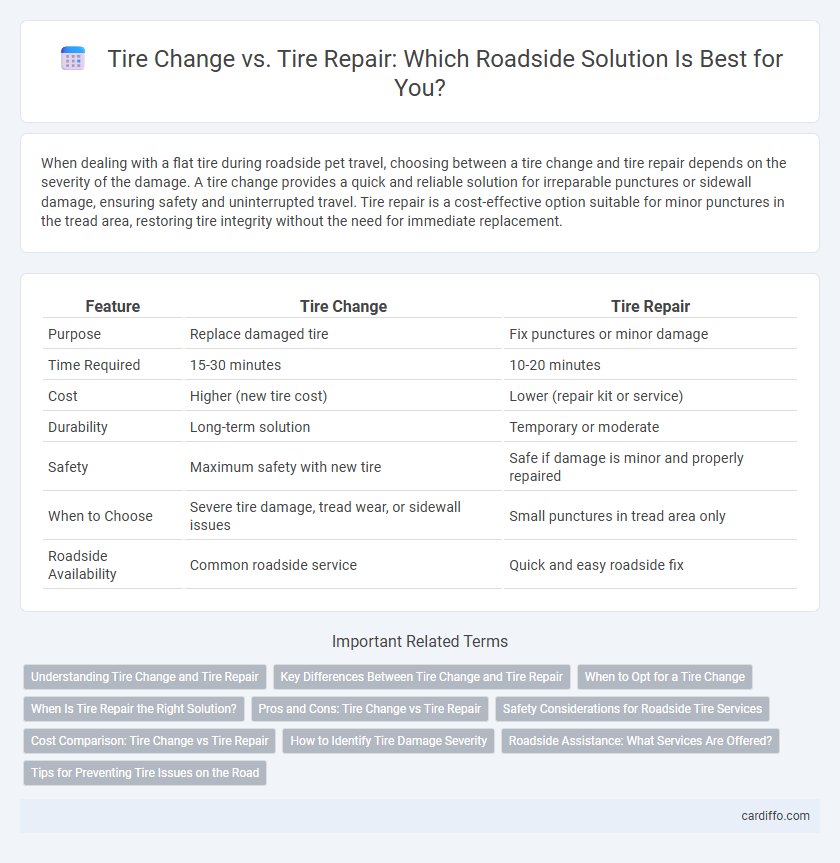When dealing with a flat tire during roadside pet travel, choosing between a tire change and tire repair depends on the severity of the damage. A tire change provides a quick and reliable solution for irreparable punctures or sidewall damage, ensuring safety and uninterrupted travel. Tire repair is a cost-effective option suitable for minor punctures in the tread area, restoring tire integrity without the need for immediate replacement.
Table of Comparison
| Feature | Tire Change | Tire Repair |
|---|---|---|
| Purpose | Replace damaged tire | Fix punctures or minor damage |
| Time Required | 15-30 minutes | 10-20 minutes |
| Cost | Higher (new tire cost) | Lower (repair kit or service) |
| Durability | Long-term solution | Temporary or moderate |
| Safety | Maximum safety with new tire | Safe if damage is minor and properly repaired |
| When to Choose | Severe tire damage, tread wear, or sidewall issues | Small punctures in tread area only |
| Roadside Availability | Common roadside service | Quick and easy roadside fix |
Understanding Tire Change and Tire Repair
Tire change involves replacing a damaged or worn tire with a new or spare tire, ensuring optimal vehicle safety and performance during roadside emergencies. Tire repair typically addresses minor issues such as punctures or small leaks, using methods like patching or plugging to restore the tire's integrity without full replacement. Choosing between tire change and repair depends on factors like tire damage severity, tread depth, and overall tire condition.
Key Differences Between Tire Change and Tire Repair
Tire change involves replacing the entire tire with a new or used one, ensuring optimal safety and performance especially when the tire is severely damaged or worn out. Tire repair targets punctures or minor damages, restoring the tire's integrity without the need for full replacement, which is cost-effective for small issues like nail punctures or leaks. Key differences include the extent of damage addressed, cost implications, and the longevity of the tire's usability after the service.
When to Opt for a Tire Change
Tire change becomes necessary when the tread depth falls below 2/32 of an inch, indicating insufficient grip and increased risk of hydroplaning. Visible sidewall damage, such as cuts or bulges, compromises tire integrity and requires replacement to ensure safety. Extensive tread wear, multiple punctures, or irreparable tire deformities make repair unviable, making tire change the most reliable choice.
When Is Tire Repair the Right Solution?
Tire repair is the right solution when the damage is limited to small punctures within the tread area, typically less than 1/4 inch in diameter, without sidewall or shoulder involvement. Repairing such punctures preserves the tire's structural integrity and extends its lifespan, ensuring safe driving conditions without immediate replacement costs. Avoid tire repair if the damage is extensive, involves the sidewall, or if the tire shows signs of uneven wear or significant tread loss, as replacement is safer in these cases.
Pros and Cons: Tire Change vs Tire Repair
Tire change ensures optimal safety and performance by replacing damaged or worn-out tires with new ones, reducing the risk of blowouts and improving traction, though it incurs higher costs and longer service times. Tire repair offers a cost-effective and quicker solution for minor punctures, preserving tire integrity and extending tire life, but it is limited to specific damage types and may compromise long-term safety if improperly done. Choosing between tire change and tire repair depends on the extent of damage, tire age, and driving conditions, balancing safety, cost, and convenience.
Safety Considerations for Roadside Tire Services
Choosing tire repair or tire change at roadside impacts vehicle safety significantly, with tire changes often recommended for severe tread damage or sidewall punctures to prevent blowouts. Repairs are typically safe for small, central tread punctures under 1/4 inch, maintaining tire integrity without compromising driving stability. Roadside safety protocols require precise assessment of tire damage, proper equipment use, and ensuring the vehicle is securely positioned off the traffic lane during service.
Cost Comparison: Tire Change vs Tire Repair
Tire repair costs typically range from $15 to $45, making it a more budget-friendly option compared to tire replacement, which averages between $100 and $250 per tire depending on the brand and size. Repairing a tire is economically advantageous when the damage is minor and located in the tread, while complete tire change becomes necessary for extensive sidewall damage or multiple punctures. Factoring in labor, tire changes generally require higher expenses due to new tire acquisition and installation fees, highlighting the importance of assessing damage severity to optimize roadside service costs.
How to Identify Tire Damage Severity
Tire damage severity can be identified by inspecting the size, location, and type of the damage; punctures smaller than 1/4 inch in the tread area are often repairable, while sidewall or large punctures typically require tire replacement. Look for visible signs such as bulges, cuts, or deep cracks, which indicate structural damage that compromises safety. Monitoring tire pressure loss and abnormalities in driving performance also helps determine whether a simple repair suffices or a full tire change is necessary.
Roadside Assistance: What Services Are Offered?
Roadside assistance services typically include both tire change and tire repair, addressing different emergency needs. Tire change involves replacing a damaged tire with a spare, ideal for situations where the tire is beyond repair. Tire repair services often include puncture sealing and patching, providing a faster and more cost-effective solution when the damage is minimal.
Tips for Preventing Tire Issues on the Road
Regularly inspecting tire pressure and tread depth significantly reduces the risk of blowouts and uneven wear on the road. Maintaining proper wheel alignment and balancing extends tire life and prevents vibrations that can lead to premature damage. Carrying a portable tire inflator and sealant kit helps address minor punctures quickly, minimizing the need for costly tire replacement during roadside emergencies.
Tire Change vs Tire Repair Infographic

 cardiffo.com
cardiffo.com